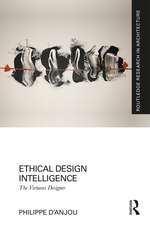Urban Connections in the Contemporary Pedestrian Landscape
Autor Philip Pregillen Limba Engleză Paperback – 4 oct 2019
Uniquely focusing on a hierarchical discussion of the quality of contemporary landscape design applications within the urban grid, and with illustrated examples throughout the text, this will be useful recommended reading for academics, researchers and postgraduate students on urban landscape and design courses.
| Toate formatele și edițiile | Preț | Express |
|---|---|---|
| Paperback (1) | 244.91 lei 6-8 săpt. | |
| Taylor & Francis – 4 oct 2019 | 244.91 lei 6-8 săpt. | |
| Hardback (1) | 765.04 lei 6-8 săpt. | |
| Taylor & Francis – oct 2019 | 765.04 lei 6-8 săpt. |
Preț: 244.91 lei
Preț vechi: 295.04 lei
-17% Nou
Puncte Express: 367
Preț estimativ în valută:
46.86€ • 49.06$ • 38.78£
46.86€ • 49.06$ • 38.78£
Carte tipărită la comandă
Livrare economică 05-19 aprilie
Preluare comenzi: 021 569.72.76
Specificații
ISBN-13: 9780815355601
ISBN-10: 0815355602
Pagini: 186
Ilustrații: 148
Dimensiuni: 156 x 234 x 11 mm
Greutate: 0.33 kg
Ediția:1
Editura: Taylor & Francis
Colecția Routledge
Locul publicării:Oxford, United Kingdom
ISBN-10: 0815355602
Pagini: 186
Ilustrații: 148
Dimensiuni: 156 x 234 x 11 mm
Greutate: 0.33 kg
Ediția:1
Editura: Taylor & Francis
Colecția Routledge
Locul publicării:Oxford, United Kingdom
Public țintă
PostgraduateCuprins
1. Contexts and Connections. 1.1 Physical and Cultural Factors. 1.2 Connections: History and Function. 1.3 Function and Opportunities. 1.4 Influences: From Form to Places. 1.5 Complexity and Coherence; Legibility and Orientation. 1.6 Aesthetics and Identity. 1.7 Contexts and Contemporary Sources. 1.8 From Contexts to Experience. 2. Connections and Pedestrian Experience. 2.1 Contexts and Primary Factors. 2.2 Connection affordance: sources and opportunities. 2.3 Gestalt, Ecological, and Predictive Coding Influences. 2.4 Contexts and Sources; Intention and Experience. 2.5 Location, Movement and Time. 2.6 Preferences and Standards. 2.7 Inductive and Deductive Applications. 2.8 Aesthetics and Identity. 2.9 Arterial, Collector and Local Connections. 3. Arterials: Conveyance and Access. 3.1Structure and Function. 3.2 Orientation and Connection. 3.3 Standards and Preferences. 3.4 Walkability: Intersections, Cross-walks. 3.5 Medians: Functions and Applications. 3.6 Complete Streets and Urban Greening. 3.7 Tactical Urbanism; Inductive and Deductive Opportunities. 3.8 Contemporary Applications and Opportunities. 4. Collectors: Diversity and Focus. 4.1 Mid-way Connections: Structure and Function. 4.2 Pedestrian Preferences and Standards. 4.3 Intersections and Cross-Connections. 4.4 Cross-walks; edges and Places. 4.5 Contemporary Applications and Effects. 4.6 Places and Interventions. 4.7 Green Avenues and Smart Streets. 4.8 Inductive and Deductive Influences; Aesthetics and Identity. 4.9 Contemporary Applications and Prospect. 5. Local Connections: Scale and Places. 5.1 Scale and Enclosure; Surfaces and Places. 5.2 Function and Standards. 5.3 Interior Transitions: Places and Details. 5.4 Contemporary Applications: Permanent and Temporary. 5.5 Green Alleys and Places. 5.6 Guerilla Gardening; Tactical Urbanism. 5.7 Experience, Aesthetics, and Identity. 5.8 Issues, Strategies and Prospect. 6. Contemporary Connections: Resources and Initiatives. 6.1 Community Vision and Outcomes. 6.2 Connections and Walkability. 6.3 Connections and Livability. 6.4 Contemporary Applications: Public and Independent. 6.5 Urban Greening: Connections and Places. 6.6 Smart Cities; Smart Streets; Complete Streets. 6.7 Information technology and Holistic Streets. 6.8 Opportunities: Working with the Context. 6.9 Inductive and Deductive Reponses. 6.10 Pedestrian Experience; Urban Identity. 7. Vision, Preferences, and Strategies. 7.1 Community Vision. 7.2 Safe streets. 7.3 Walkability and Livability. 7.4 Shared Streets. 7.5 Complete Streets. 7.6. Aesthetics and Identity. 7.7 Preferences: Safety and Walkability. 7.8 Edges and Amenities. 7.9 Inductive and Deductive Influences and Identity. 7.10 Strategies and Initiatives. 7.11 Downtown Contexts. 7.12 Connections and Prospect. Index
Notă biografică
Philip Pregill is Professor in the Department of Landscape Architecture at California State Polytechnic University, Pomona. From 2000 to 2008, he was Chair of the department at Cal Poly, Pomona. Previous employment in education included a tenured Associate Professor position in the Department of Landscape Architecture, Texas A&M University, College Station Texas.
Descriere
This book explores the significant physical and cultural changes in our urban areas following the implementation of design strategies and increased pedestrian activity. It focuses on a hierarchical discussion of the quality of contemporary landscape design applications within the urban grid, and has illustrated examples throughout the text.














